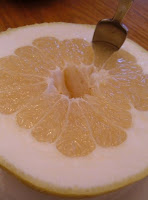Natural Anti-Diabetes "Drug": Naringin Turns Out to Be More Effective Than Rosiglitazone Against Insulin Resistance, Hyperinsulinaemia, Hyperglycaemia, Dyslipidaemia, Inflammation, and Organ Damage.
 |
| Image: Grapefruits, here one from the sunny state of California, contain bioflavonids that are more potent than common diabetes drugs. |
Attention Type I Diabetics: Just today ScienceDaily reports that a clinical trial with the generic drug BCG (bacillus Calmette-Guerin) to treat advanced type I diabetes was just started - so while naringin alone probably won't help you, you may want to look into this.
Whether you want to consider that coincidental or not, the study (Sharma. 2011) on the effects of the grapefruit bioflavonid naringin, the results of which I am about to summarize in the following, neither comes from one of the federally funded research centers in the US or Europe, nor was it financed by one of the big pharma companies, who spend billions of research-dollars on the development of new patentable drugs for their highly profitable 'crusade' against the global obesity and diabetes epidemic. |
| Figure 1: Markers of blood glucose management (primary axes) and inflammation (secondary axes) in control and streptozotocin-induced rat model of type II after 28 days on naringine (25 or 100mg/kg) or the common diabetes drug rosglitazone (data adapted from Sharma. 2011) |
Naringin significantly decreased IR, hyperinsulinaemia, hyperglycaemia, dyslipidaemia, TNF-a, IL-6, C-reactive protein and concomitantly increased adiponectin and b-cell function in a dose-dependent manner. Increased thiobarbituric acid-reactive substances and decreased antioxidant enzyme activities in the serum and tissues of diabetic rats were also normalised. Moreover, naringin robustly increased PPARg expression in liver and kidney [PPARg is known to increase fatty acid metabolism and reduce triglycerides]; phosphorylated tyrosine insulin receptor substrate 1 in liver; and stress proteins heat shock protein (HSP)-27 and HSP-72 in pancreas, liver and kidney. In contrast, NF-kB [one of the most important inflammatory cytokines] expression in these tissues along with sterol regulatory element binding protein-1c and liver X receptor- expressions in liver were significantly diminished. In addition, microscopic observations validated that naringin effectively rescues b-cells, hepatocytes and kidney from HFD-STZ-mediated oxidative damage and pathological alterations.Furthermore, the effects of 28 days on high dose naringin supplementation on glucose management were identical the ones on blood lipids even superior to the pharmacological standard treatment with rosiglitazone, which was administered to another group of previously streptozotocin-treated and thus diabetic rats:
Naringin dose dependently attenuated hyperglycaemia, hyperinsulinaemia and IR, so that the naringin 100 mg/kg group was not different from the standard drug rosiglitazone group.[...] Naringin at 50 and 100 mg/kg significantly (P,0·001) decreased [blood lipids] compared with diabetic control rats and the effect was more pronounced than with rosiglitazone.For all non-diabetics out there, it may be worth mentioning that even your weight-loss efforts may be from the activation of PPARg and the upregulation of liver X receptor-expression. And, as if this was not enough, its activation of heat-shock proteins may even facilitate muscle gains - at least the elevation of the same proteins after functional overload of skeletal muscle would suggest so (Huey. 2010). So, if you think your body could use a little help in managing blood glucose, lipids or just the amount of adipose tissue it is carrying; and you want to kickstart your journey into a new healthier life with some grapefruit bioflavenoids, you either go and buy a supplement or have a closer look at the data in figure 2 in order to decide which and how many grapefruits you will be buying on your next trip to the grocery store:
 |
| Figure 2: Naringin content of self-made grapefruit juice in mg/l using different means of preparation and fruits from different producers (data adapted from Ho. 2000) |


